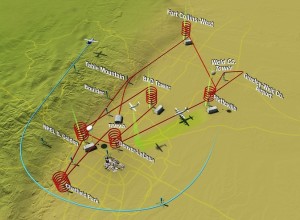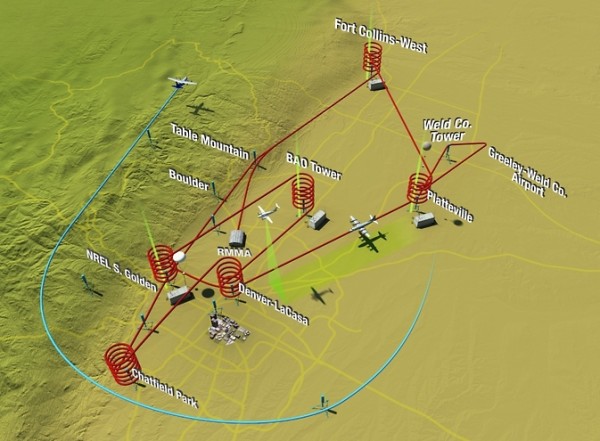 The airspace around Denver will be busy from July 16 to August 16, but it won’t have anything to do with the traffic at the Denver airport. Instead it will be due to a cooperative effort between NASA and the National Science Foundation (NSF) to study air quality and improve the ability to diagnose air quality conditions from space.
The airspace around Denver will be busy from July 16 to August 16, but it won’t have anything to do with the traffic at the Denver airport. Instead it will be due to a cooperative effort between NASA and the National Science Foundation (NSF) to study air quality and improve the ability to diagnose air quality conditions from space.
Taking part in the research will be two NASA aircraft along with a research aircraft from the NSF. The effort will be coordinated by the Research Aviation Facility maintained by the National Center for Atmospheric Research (NCAR) in Boulder, Colorado.

The aircraft will fly research missions around an area which extends along the Northern Front Range, from the Denver metropolitan area in the south to Fort Collins in the north extending eastward from the mountains as far as Greeley.
The area was selected for the study because it “contains a diverse mixture of air pollution sources that include transportation, power generation, oil and gas extraction, agriculture, natural vegetation and episodic wildfires,” reported a NASA press release.
The release also mentioned that this area of the US also “often experiences ozone levels in summer that exceed national health standards.”
For the NASA team, this Colorado study is the last of four studies performed, including the Baltimore-Washington area in 2011, and California’s San Joaquin Valley and Houston both in 2013.
The research flights are being closely coordinated with air quality observations on the ground at sites maintained by the Colorado Department of Public Health and Environment and the National Oceanic and Atmospheric Administration and will help improve the capability of future satellites to monitor air quality around the world.
“Satellites looking down through the atmosphere have a difficult time distinguishing between pollution at the surface and aloft,” said Jim Crawford from NASA Langley Research Center in Hampton, Virginia. “The ‘vertically resolved’ observations gathered by the two NASA planes flying one above the other and above the ground sites offer the details needed to better understand how to connect these two views.”
![Herbal Reference Substances are Key to Everyday Products <!-- AddThis Sharing Buttons above -->
<div class="addthis_toolbox addthis_default_style " addthis:url='http://newstaar.com/herbal-reference-substances-are-key-to-everyday-products/3512112/' >
<a class="addthis_button_facebook_like" fb:like:layout="button_count"></a>
<a class="addthis_button_tweet"></a>
<a class="addthis_button_pinterest_pinit"></a>
<a class="addthis_counter addthis_pill_style"></a>
</div>When it comes to quality control testing and the development of new products, Botanical Reference Materials (BRMs), also known as Herbal References are critically important. To help companies ultimately obtain all-important FDA approval, the Food and Drug Administration provides in its guidance a recommendation that […]<!-- AddThis Sharing Buttons below -->
<div class="addthis_toolbox addthis_default_style addthis_32x32_style" addthis:url='http://newstaar.com/herbal-reference-substances-are-key-to-everyday-products/3512112/' >
<a class="addthis_button_preferred_1"></a>
<a class="addthis_button_preferred_2"></a>
<a class="addthis_button_preferred_3"></a>
<a class="addthis_button_preferred_4"></a>
<a class="addthis_button_compact"></a>
<a class="addthis_counter addthis_bubble_style"></a>
</div>](http://newstaar.com/wp-content/uploads/2021/02/Achillea_millefolium_flowers-100x100.jpg)
![Quality Electrochemical Biosensors are Critical for Medical, Food and Chemical Industry <!-- AddThis Sharing Buttons above -->
<div class="addthis_toolbox addthis_default_style " addthis:url='http://newstaar.com/quality-electrochemical-biosensors-are-critical-for-medical-food-and-chemical-industry/3512086/' >
<a class="addthis_button_facebook_like" fb:like:layout="button_count"></a>
<a class="addthis_button_tweet"></a>
<a class="addthis_button_pinterest_pinit"></a>
<a class="addthis_counter addthis_pill_style"></a>
</div>A number of industries have, at their core, a need to frequent or even continuous analysis of biological media. These include the medical and pharmaceutical fields, biotech firms, and food and chemical companies. To maintain quality standards and develop new products, these industries rely heavily […]<!-- AddThis Sharing Buttons below -->
<div class="addthis_toolbox addthis_default_style addthis_32x32_style" addthis:url='http://newstaar.com/quality-electrochemical-biosensors-are-critical-for-medical-food-and-chemical-industry/3512086/' >
<a class="addthis_button_preferred_1"></a>
<a class="addthis_button_preferred_2"></a>
<a class="addthis_button_preferred_3"></a>
<a class="addthis_button_preferred_4"></a>
<a class="addthis_button_compact"></a>
<a class="addthis_counter addthis_bubble_style"></a>
</div>](http://newstaar.com/wp-content/uploads/2020/10/Electrochemical-Biosensor-100x100.jpg)
![Company Develops Industrial Mixers Well-Suited for both Fragile and Explosive Products <!-- AddThis Sharing Buttons above -->
<div class="addthis_toolbox addthis_default_style " addthis:url='http://newstaar.com/company-develops-industrial-mixers-well-suited-for-both-fragile-and-explosive-products/3512071/' >
<a class="addthis_button_facebook_like" fb:like:layout="button_count"></a>
<a class="addthis_button_tweet"></a>
<a class="addthis_button_pinterest_pinit"></a>
<a class="addthis_counter addthis_pill_style"></a>
</div>Industrial drum mixers are normally applied to blend mixes of varying viscosities such as adhesive slurries or cement. Some of these mixers have the capability of blending mixes of very different particle sizes such as fruit and ice cream, and gravel and cement slurry. The […]<!-- AddThis Sharing Buttons below -->
<div class="addthis_toolbox addthis_default_style addthis_32x32_style" addthis:url='http://newstaar.com/company-develops-industrial-mixers-well-suited-for-both-fragile-and-explosive-products/3512071/' >
<a class="addthis_button_preferred_1"></a>
<a class="addthis_button_preferred_2"></a>
<a class="addthis_button_preferred_3"></a>
<a class="addthis_button_preferred_4"></a>
<a class="addthis_button_compact"></a>
<a class="addthis_counter addthis_bubble_style"></a>
</div>](http://newstaar.com/wp-content/uploads/2020/06/bandeau-sofragir2-100x100.jpg)